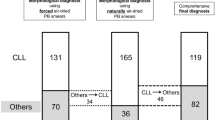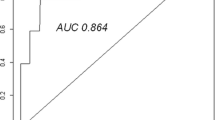Abstract
Monoclonal B cell lymphocytosis (MBL) is both a marker of immune senescence and a potential precursor of B cell malignancy. Most MBL populations have a chronic lymphocytic leukemia-like (CLL-like) immunophenotype, but those that are CD5-negative (non-CLL-like) are also recognized and may represent a distinct diagnostic entity. To date, MBL studies have taken place in relatively homogenous populations, although risk of CLL varies across racial groups and geographic regions. We report flow cytometry data from 597 ethnically diverse 64–94-year-old women from across the USA who are participants in the Women’s Health Initiative (WHI) Long-Life Study (LLS). Overall, MBL was detected in 26 % of the participants and included 20.9 % with a CLL-like immunophenotype, 5 % with a non-CLL-like immunophenotype, and 1.3 % with both. White and Hispanic women were more than twice as likely to have a CLL-like MBL population detected than African American women, corrected for age (P = 0.003). By contrast, detection of non-CLL-like MBL did not vary significantly by race, but did increase markedly with advancing age, being present in 12.7 % of those aged 85 and older. We provide new evidence that rates of detection of CLL-like MBL are lower in African Americans, and further suggest that non-CLL-like clonal expansions should be regarded as distinct from CLL-like MBL.



Similar content being viewed by others
References
Nieto WG, Almeida J, Romero A, Teodosio C, Lopez A, Henriques AF, Sanchez ML, Jara-Acevedo M, Rasillo A, Gonzalez M, Fernandez-Navarro P, Vega T, Orfao A, Primary Health Care Group of Salamanca for the Study of MBL (2009) Increased frequency (12%) of circulating chronic lymphocytic leukemia-like B-cell clones in healthy subjects using a highly sensitive multicolor flow cytometry approach. Blood 114(1):33–37. doi:10.1182/blood-2009-01-197368
Shim YK, Middleton DC, Caporaso NE, Rachel JM, Landgren O, Abbasi F, Raveche ES, Rawstron AC, Orfao A, Marti GE, Vogt RF (2010) Prevalence of monoclonal B-cell lymphocytosis: a systematic review. Cytometry B Clin Cytom 78(Suppl 1):S10–18. doi:10.1002/cyto.b.20538
Shim YK, Rachel JM, Ghia P, Boren J, Abbasi F, Dagklis A, Venable G, Kang J, Degheidy H, Plapp FV, Vogt RF, Menitove JE, Marti GE (2014) Monoclonal B-cell lymphocytosis in healthy blood donors: an unexpectedly common finding. Blood 123(9):1319–1326. doi:10.1182/blood-2013-08-523704
Scarfo L, Dagklis A, Scielzo C, Fazi C, Ghia P (2010) CLL-like monoclonal B-cell lymphocytosis: are we all bound to have it? Semin Cancer Biol 20(6):384–390. doi:10.1016/j.semcancer.2010.08.005
Shanafelt TD, Ghia P, Lanasa MC, Landgren O, Rawstron AC (2010) Monoclonal B-cell lymphocytosis (MBL): biology, natural history and clinical management. Leukemia 24(3):512–520. doi:10.1038/leu.2009.287
Mulligan CS, Thomas ME, Mulligan SP (2011) Monoclonal B-lymphocytosis: demographics, nature and subclassification in 414 community patients. Leuk Lymphoma 52(12):2293–2298. doi:10.3109/10428194.2011.598250
Jaso JM, Yin CC, Wang SA, Miranda RN, Jabcuga CE, Chen L, Medeiros LJ (2013) Clinicopathologic features of CD5-positive nodal marginal zone lymphoma. Am J Clin Pathol 140(5):693–700. doi:10.1309/AJCPEMVXES72DUIF
Xochelli A, Kalpadakis C, Gardiner A, Baliakas P, Vassilakopoulos TP, Mould S, Davis Z, Stalika E, Kanellis G, Angelopoulou MK, McIver-Brown N, Ibbotson R, Sachanas S, Korkolopoulou P, Athanasiadou A, Anagnostopoulos A, Papadaki HA, Papadaki T, Stamatopoulos K, Pangalis GA, Oscier D (2014) Clonal B-cell lymphocytosis exhibiting immunophenotypic features consistent with a marginal-zone origin: is this a distinct entity? Blood 123(8):1199–1206. doi:10.1182/blood-2013-07-515155
Rawstron AC, Bennett FL, O’Connor SJ, Kwok M, Fenton JA, Plummer M, de Tute R, Owen RG, Richards SJ, Jack AS, Hillmen P (2008) Monoclonal B-cell lymphocytosis and chronic lymphocytic leukemia. N Engl J Med 359(6):575–583. doi:10.1056/NEJMoa075290
Landgren O, Albitar M, Ma W, Abbasi F, Hayes RB, Ghia P, Marti GE, Caporaso NE (2009) B-cell clones as early markers for chronic lymphocytic leukemia. N Engl J Med 360(7):659–667. doi:10.1056/NEJMoa0806122
Rawstron AC, Shanafelt T, Lanasa MC, Landgren O, Hanson C, Orfao A, Hillmen P, Ghia P (2010) Different biology and clinical outcome according to the absolute numbers of clonal B-cells in monoclonal B-cell lymphocytosis (MBL). Cytometry B Clin Cytom 78(Suppl 1):S19–23. doi:10.1002/cyto.b.20533
Caporaso NE, Marti GE, Landgren O, Azzato E, Weinberg JB, Goldin L, Shanafelt T (2010) Monoclonal B cell lymphocytosis: clinical and population perspectives. Cytometry B Clin Cytom 78(Suppl 1):S115–119. doi:10.1002/cyto.b.20555
Ponzoni M, Ghia P (2014) Clonal B-cell lymphocytosis: a new member? Blood 123(8):1118–1119. doi:10.1182/blood-2013-12-543330
Arnold CR, Wolf J, Brunner S, Herndler-Brandstetter D, Grubeck-Loebenstein B (2011) Gain and loss of T cell subsets in old age—age-related reshaping of the T cell repertoire. J Clin Immunol 31(2):137–146. doi:10.1007/s10875-010-9499-x
Sansoni P, Vescovini R, Fagnoni F, Biasini C, Zanni F, Zanlari L, Telera A, Lucchini G, Passeri G, Monti D, Franceschi C, Passeri M (2008) The immune system in extreme longevity. Exp Gerontol 43(2):61–65. doi:10.1016/j.exger.2007.06.008
Naylor K, Li G, Vallejo AN, Lee WW, Koetz K, Bryl E, Witkowski J, Fulbright J, Weyand CM, Goronzy JJ (2005) The influence of age on T cell generation and TCR diversity. J Immunol 174(11):7446–7452
Almeida J, Nieto WG, Teodosio C, Pedreira CE, Lopez A, Fernandez-Navarro P, Nieto A, Rodriguez-Caballero A, Munoz-Criado S, Jara-Acevedo M, Romero A, Orfao A, Primary Health Care Group of Salamanca for the Study of MBL (2011) CLL-like B-lymphocytes are systematically present at very low numbers in peripheral blood of healthy adults. Leukemia 25(4):718–722. doi:10.1038/leu.2010.305
Shenoy PJ, Malik N, Sinha R, Nooka A, Nastoupil LJ, Smith M, Flowers CR (2011) Racial differences in the presentation and outcomes of chronic lymphocytic leukemia and variants in the United States. Clin Lymphoma Myeloma Leuk 11(6):498–506. doi:10.1016/j.clml.2011.07.002
Goldin LR, Slager SL, Caporaso NE (2010) Familial chronic lymphocytic leukemia. Curr Opin Hematol 17(4):350–355. doi:10.1097/MOH.0b013e328338cd99
Ghia P, Prato G, Scielzo C, Stella S, Geuna M, Guida G, Caligaris-Cappio F (2004) Monoclonal CD5+ and CD5- B-lymphocyte expansions are frequent in the peripheral blood of the elderly. Blood 103(6):2337–2342. doi:10.1182/blood-2003-09-3277
Nieto WG, Almeida J, Teodosio C, Abbasi F, Allgood SD, Connors F, Rachel JM, Ghia P, Lanasa MC, Rawstron AC, Orfao A, Caporaso NE, Hanson CA, Shim YK, Vogt RF, Marti GE (2010) Commentary: comparison of current flow cytometry methods for monoclonal B cell lymphocytosis detection. Cytometry B Clin Cytom 78(Suppl 1):S4–9. doi:10.1002/cyto.b.20556
Curb JD, McTiernan A, Heckbert SR, Kooperberg C, Stanford J, Nevitt M, Johnson KC, Proulx-Burns L, Pastore L, Criqui M, Daugherty S, Morbidity WHI, Mortality C (2003) Outcomes ascertainment and adjudication methods in the Women’s Health Initiative. Ann Epidemiol 13(9 Suppl):S122–128
Sriram U, LaCroix AZ, Barrington WE, Corbie-Smith G, Garcia L, Going SB, LaMonte MJ, Manson JE, Sealy-Jefferson S, Stefanick ML, Waring ME, Seguin RA (2016) Neighborhood Walkability and Adiposity in the Women’s Health Initiative Cohort. American journal of preventive medicine. doi:10.1016/j.amepre.2016.04.007
Deddens JA, Petersen MR (2008) Approaches for estimating prevalence ratios. Occup Environ Med 65(7):481. doi:10.1136/oem.2007.034777, 501-486
Soosapilla A, Pepperell D, Best G, Brizzi C, Mulligan CS, van Bilsen N, Mulligan SP (2015) Monoclonal B-lymphocytosis in patients aged over 90 years is common but not inevitable, and has a prevalence comparable to that in individuals aged 65-90 years. Leukemia & lymphoma:1-3. doi:10.3109/10428194.2014.976822
Yang SM, Li JY, Gale RP, Huang XJ (2015) The mystery of chronic lymphocytic leukemia (CLL): Why is it absent in Asians and what does this tell us about etiology, pathogenesis and biology? Blood Rev 29(3):205–213. doi:10.1016/j.blre.2014.12.001
Pan JW, Cook LS, Schwartz SM, Weis NS (2002) Incidence of leukemia in Asian migrants to the United States and their descendants. Cancer Causes Control 13(9):791–795
Mak V, Ip D, Mang O, Dalal C, Huang S, Gerrie A, Gillan T, Ramadan KM, Toze C, Au WY (2014) Preservation of lower incidence of chronic lymphocytic leukemia in Chinese residents in British Columbia: a 26-year survey from 1983 to 2008. Leuk Lymphoma 55(4):824–827. doi:10.3109/10428194.2013.827785
Goldin LR, Pfeiffer RM, Li X, Hemminki K (2004) Familial risk of lymphoproliferative tumors in families of patients with chronic lymphocytic leukemia: results from the Swedish family-cancer database. Blood 104(6):1850–1854. doi:10.1182/blood-2004-01-0341
Goldin LR, Lanasa MC, Slager SL, Cerhan JR, Vachon CM, Strom SS, Camp NJ, Spector LG, Leis JF, Morrison VA, Glenn M, Rabe KG, Achenbach SJ, Algood SD, Abbasi F, Fontaine L, Yau M, Rassenti LZ, Kay NE, Call TG, Hanson CA, Weinberg JB, Marti GE, Caporaso NE (2010) Common occurrence of monoclonal B-cell lymphocytosis among members of high-risk CLL families. Br J Haematol 151(2):152–158. doi:10.1111/j.1365-2141.2010.08339.x
Khalil MO, Morton LM, Devesa SS, Check DP, Curtis RE, Weisenburger DD, Dores GM (2014) Incidence of marginal zone lymphoma in the United States, 2001-2009 with a focus on primary anatomic site. Br J Haematol 165(1):67–77. doi:10.1111/bjh.12730
Dagklis A, Fazi C, Sala C, Cantarelli V, Scielzo C, Massacane R, Toniolo D, Caligaris-Cappio F, Stamatopoulos K, Ghia P (2009) The immunoglobulin gene repertoire of low-count chronic lymphocytic leukemia (CLL)-like monoclonal B lymphocytosis is different from CLL: diagnostic implications for clinical monitoring. Blood 114(1):26–32. doi:10.1182/blood-2008-09-176933
Wood B (2006) 9-color and 10-color flow cytometry in the clinical laboratory. Arch Pathol Lab Med 130(5):680–690. doi:10.1043/1543-2165(2006)130[680:CACFCI]2.0.CO;2
Chen X, Xie H, Wood BL, Walter RB, Pagel JM, Becker PS, Sandhu VK, Abkowitz JL, Appelbaum FR, Estey EH (2015) Relation of clinical response and minimal residual disease and their prognostic impact on outcome in acute myeloid leukemia. Journal of clinical oncology : official journal of the American Society of Clinical Oncology. doi:10.1200/JCO.2014.58.3518
Bar M, Wood BL, Radich JP, Doney KC, Woolfrey AE, Delaney C, Appelbaum FR, Gooley TA (2014) Impact of minimal residual disease, detected by flow cytometry, on outcome of myeloablative hematopoietic cell transplantation for acute lymphoblastic leukemia. Leukemia research and treatment 2014:421723. doi:10.1155/2014/421723
Voigtlaender M, Vogler B, Trepel M, Panse J, Jung R, Bokemeyer C, Bacher U, Binder M (2015) Hospital population screening reveals overrepresentation of CD5(-) monoclonal B-cell lymphocytosis and monoclonal gammopathy of undetermined significance of IgM type. Ann Hematol 94(9):1559–1565. doi:10.1007/s00277-015-2409-9
Marti GE, Rawstron AC, Ghia P, Hillmen P, Houlston RS, Kay N, Schleinitz TA, Caporaso N, International Familial CLLC (2005) Diagnostic criteria for monoclonal B-cell lymphocytosis. Br J Haematol 130(3):325–332. doi:10.1111/j.1365-2141.2005.05550.x
Author information
Authors and Affiliations
Corresponding author
Ethics declarations
Conflict of interest
The authors declare that they have no conflict of interest.
Financial support
The WHI program is funded by the National Heart, Lung, and Blood Institute, National Institutes of Health, U.S. Department of Health and Human Services through contracts HHSN268201100046C, HHSN268201100001C, HHSN268201100002C, HHSN268201100003C, HHSN268201100004C, and HHSN271201100004C.
Potential conflicts of interest and disclosures
The authors have no potential conflicts of interest to declare. All procedures followed were in accordance with the ethical standards of the responsible committee on human experimentation (institutional and national) and with the Helsinki Declaration of 1975, as revised in 2008.
Electronic supplementary material
Below is the link to the electronic supplementary material.
ESM 1
(DOC 62 kb)
Rights and permissions
About this article
Cite this article
Edlefsen, K.L., Cherian, S., De Roos, A.J. et al. Detection of non-CLL-like monoclonal B cell lymphocytosis increases dramatically in the very elderly, while detection of CLL-like populations varies by race: findings in a multiethnic population-based cohort of elderly women. Ann Hematol 95, 1695–1704 (2016). https://doi.org/10.1007/s00277-016-2760-5
Received:
Accepted:
Published:
Issue Date:
DOI: https://doi.org/10.1007/s00277-016-2760-5




